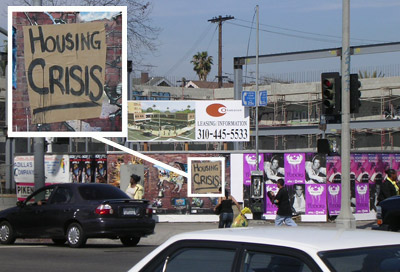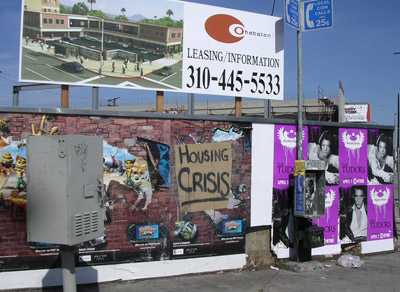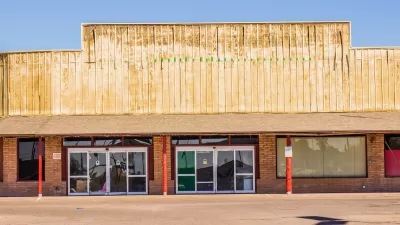This message is brought to you by the frustrated residents of a city where strip malls prosper and the stock of affordable housing struggles to keep up with demand. A new strip mall being constructed at the intersection of Venice Blvd. and Western Ave. in Los Angeles inspired this public display. Strip malls are in no short supply in L.A., and this is just one example of yet another being built in the city. Unmixed-use retail developments like this are popping up all over the place. Much less new housing is being built. And a sharply lower amount of new affordable housing is being built.
This message is brought to you by the frustrated residents of a city where strip malls prosper and the stock of affordable housing struggles to keep up with demand.

A new strip mall being constructed at the intersection of Venice Blvd. and Western Ave. in Los Angeles inspired this public display.
Strip malls are in no short supply in L.A., and this is just one example of yet another being built in the city. Unmixed-use retail developments like this are popping up all over the place. Much less new housing is being built. And a sharply lower amount of new affordable housing is being built.
According to the Los Angeles Department of City Planning, nearly 600,000 square feet of retail space was constructed between April 1 and June 3, 2006. This compares to 624 new dwelling units in multi-family developments constructed in that same period. In square footage, these two amounts are about equal.
But the city's housing shortage can be witnessed in the following figures: L.A. County's population increased by more than 1.3 million people between 1990 and 2006, while only about 200,000 housing units were built. This was reported in a report recently released by the Greater Los Angeles/Ventura County Chapter of the Building Industry Association (BIA/GLAV) and the Los Angeles County Economic Development Corporation (LAEDC).
The U.S. Census Bureau's American Community Survey data for 2005 shows that the median household value in the city is more than $500,000. And of the city's roughly 775,000 renters, about 350,000 pay at least 35% of their income on housing.
The L.A. Housing Department reports that about 100,000 households occupy housing that is subsidized in some way.
The city's housing department hosts a list of all the affordable housing projects it has developed. There are currently 286 projects on this list, each having an average of about 5 units designated as "affordable". The average income requirement for these units is about 60% percent of the city's median household income of $42,000. But most of these units are already occupied. And with subsidies expiring, a significant amount of the city's affordable housing stock is reverting to the market rate.

While the term "housing crisis" can be proved or disproved by a wide variety of statistics, there does seem to be a shortage. This message -- whether you call it graffiti or a public service announcement -- attempts to call attention to some significant issues facing the city. But, valid social commentary or not, the space it occupied has a price. And within days some advertiser paid that price, pulling L.A.'s housing crisis out of the general public's sight, and (most likely) back out of its collective mind.

Planetizen Federal Action Tracker
A weekly monitor of how Trump’s orders and actions are impacting planners and planning in America.

San Francisco's School District Spent $105M To Build Affordable Housing for Teachers — And That's Just the Beginning
SFUSD joins a growing list of school districts using their land holdings to address housing affordability challenges faced by their own employees.

The Tiny, Adorable $7,000 Car Turning Japan Onto EVs
The single seat Mibot charges from a regular plug as quickly as an iPad, and is about half the price of an average EV.

San Diego Votes to Rein in “Towering” ADUs
City council voted to limit the number of units in accessory buildings to six — after confronting backyard developments of up to 100 units behind a single family home.

Texas Legislature’s Surprising Pro-Housing Swing
Smaller homes on smaller lots, office to apartment conversions, and 40% less say for NIMBYs, vote state lawmakers.

Even Edmonton Wants Single Staircase Buildings
Canada's second most affordable major city joins those angling to nix the requirement for two staircases in multi-family buildings.
Urban Design for Planners 1: Software Tools
This six-course series explores essential urban design concepts using open source software and equips planners with the tools they need to participate fully in the urban design process.
Planning for Universal Design
Learn the tools for implementing Universal Design in planning regulations.
Borough of Carlisle
Smith Gee Studio
City of Camden Redevelopment Agency
City of Astoria
Transportation Research & Education Center (TREC) at Portland State University
City of Camden Redevelopment Agency
Municipality of Princeton (NJ)





























